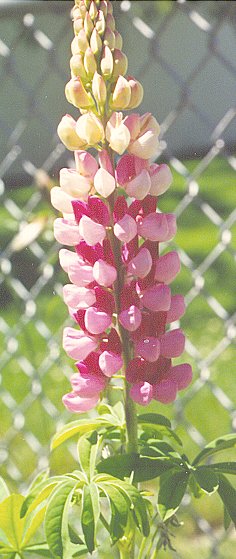


|
|
I once got interested in lupines when I saw them growing wild in Eastern Canada, I thought they were wild lupines (L. perennis) but now that I have a few L. perennis going I wonder if the ones in Canada were Russell lupines gone wild. At any rate Russell lupines are native to the mountains of British Columbia and were bred in England by a botanist named Russell. They come in many solid colors and bi-colors and the seeds are easy to find in stores. Bumblebees love the flowers. In Chicago the flowers start to open around the end of May. Supposedly you can often get a second batch of flowers if you cut flowing stalks down to the ground however I've never tried this, I like to let nature take its course. Russell lupines typically get 3 feet high when flowering however I did have one that managed to get a few inches over 4 feet.
To get seeds started you have a number of alternatives. Maybe the best is to plant them in late winter just after the ground has thawed since the cold helps them sprout. If planted in the fall some seeds will sprout in the fall while most will come up in the spring. To get them going in late spring or summer soak them in water overnight, this will make the seeds swell up and start the growth of the seed. To start seeds from an existing plant, wait until the seed pod just turns black then pick the pod, open it up and plant the seeds before they shrink. If you wait too long the seeds will shrink as they dry out and the water treatment is necessary. If you wait too long the seed pod will open with a snap and fling the seeds all over your garden, then in the fall and the following spring you will have plants coming up in odd places.
Transplanting is said to be difficult but the sources say that small plants can be easily moved if you keep a lot of soil around the roots. This has not worked well for me, plants do best when they start growing where they were planted. I have managed to move a couple of larger, older plants successfully in late fall when the temperature hovers around freezing.
Some plants are vigorous and may get fairly large the first year while others grow slowly. One variety has been bred to bloom the first year but the regular variety will not bloom the first year, it will probably bloom the following year but this is not guaranteed by any means, plants that grow slowly won't even bloom in their second year.
The location of the plants can be important because hot dry weather will cause the flower spikes to wilt. Even if you rush water to them the flowers on the top of the flower spike will fall off prematurely. Thus giving them a little afternoon shade will often help, they are after all native to the mountains of British Columbia where they are used to cool, damp conditions. Some plants will take the heat in stride and will not wilt but then you won't know which ones these are until you see what they do. You can plant lupines on the north side of a house where they get only a little morning and evening sun and they are likely to bloom a little although sometimes a plant will not bloom at all under these conditions.
Some plants will die after blooming once. If you examine the dead plant you will find the root rotted away. If they make it through the year they bloom it seems you will get blooms for three years in a row and then there is a good chance they will die. If a plant makes it past three years of blooms there is a good chance it will continue on for many years, I have one that is at least 20 years old. It seems older plants manage to keep going because they put out new roots and stalks so while some portions of the roots will rot away other portions will not.
Some sources say that lupines need an acid soil but here in Chicago where the soil tends toward alkaline lupines do just fine. I avoid fertilizing in hot, dry weather. (For that matter don't use chemical fertilizers on ANY plant that is stressed due to hot, dry conditions. Chemical fertilizers are just different types of salts and will damage a plant that is stressed.) I've used Miracle-Gro and MirAcid and the K-Mart equivalents. I've also used bone meal and water soluble kelp extract.
Cover the plants with leaves in the winter after the ground is solidly frozen to keep freezes and thaws from heaving the plants out of the ground.